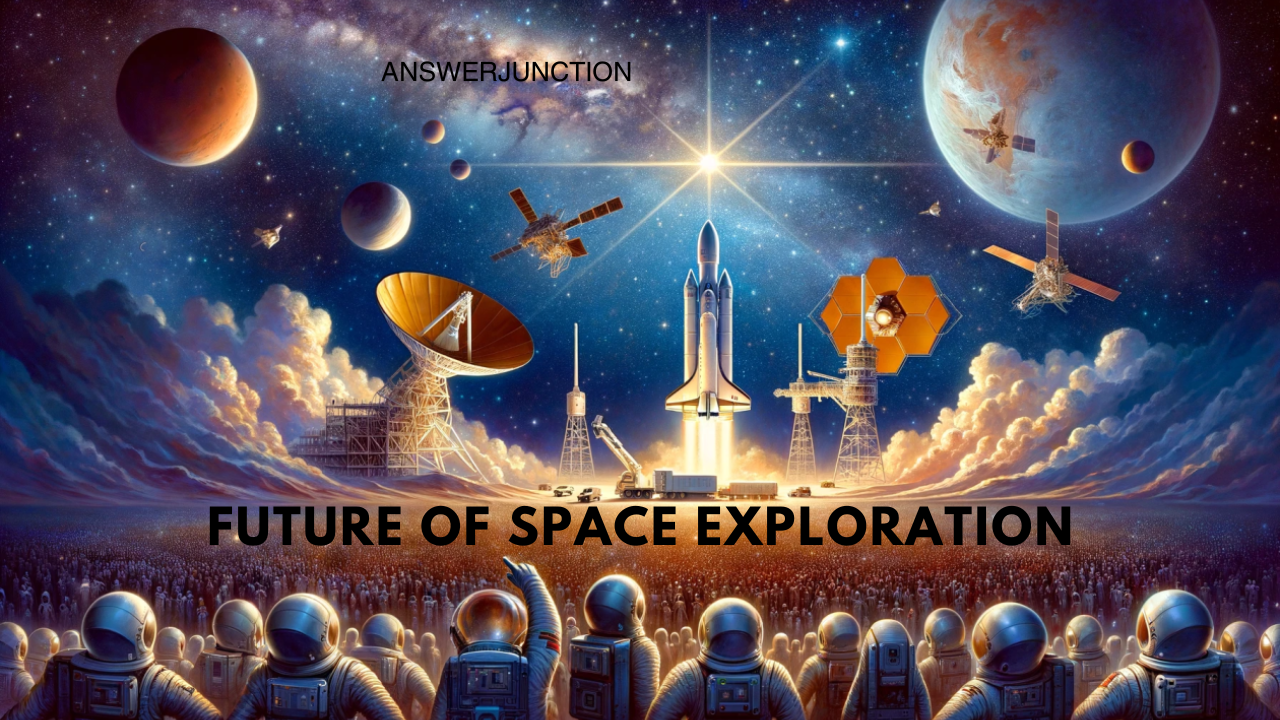Space exploration has captivated humanity for centuries, inspiring awe and curiosity about the universe beyond our planet. From the early days of astronomy to the groundbreaking missions of the 20th and 21st centuries, the pursuit of knowledge about outer space has continually evolved. Today, we stand on the brink of a new era in space exploration, propelled by advances in technology that promise to redefine our understanding of the cosmos. In this article, we will explore the future of space exploration, highlighting the technological innovations that are making it possible, the missions on the horizon, and the potential implications for humanity.
The Evolution of Space Exploration Technology

A Brief History
The journey of space exploration began in the mid-20th century with the launch of Sputnik 1 by the Soviet Union in 1957, marking humanity’s first venture into space. This event spurred a technological race between the United States and the USSR, culminating in the Apollo missions that landed humans on the Moon. The subsequent decades saw the development of space shuttles, space stations, and robotic missions to distant planets.
However, the pace of space exploration slowed in the late 20th century as funding dwindled and public interest waned. In recent years, a resurgence of interest, fueled by technological advancements and private sector involvement, has reinvigorated the field. New technologies are transforming how we explore space, allowing for more ambitious missions and a deeper understanding of our universe.
Key Technological Innovations
Several key technological advancements are driving the future of space exploration:
- Reusable Rockets: Companies like SpaceX have pioneered the development of reusable rocket technology, significantly reducing the cost of launching payloads into space. The Falcon 9 rocket’s ability to land back on Earth after delivering its cargo has revolutionized space travel, making it more economically viable.
- Advanced Propulsion Systems: The development of advanced propulsion technologies, such as ion propulsion and nuclear thermal propulsion, holds the potential to reduce travel times to distant destinations. Ion thrusters, which use electric fields to accelerate ions, offer high efficiency for long-duration missions, while nuclear thermal propulsion promises faster travel times for crewed missions to Mars.
- Artificial Intelligence (AI): AI is becoming increasingly integral to space exploration. From autonomous spacecraft navigation to data analysis from remote sensing instruments, AI enhances decision-making processes and enables more efficient mission planning. For example, NASA’s Mars rovers utilize AI algorithms to navigate the Martian terrain autonomously.
- 3D Printing: The ability to 3D print tools, parts, and even habitats in space can significantly reduce the need for transporting everything from Earth. This technology opens up new possibilities for building infrastructure on the Moon or Mars, potentially allowing astronauts to create what they need on-site.
- Robotic Exploration: Robots have played a crucial role in space exploration, and their capabilities continue to advance. Missions like the Mars Perseverance rover and the James Webb Space Telescope exemplify the power of robotics in gathering data and conducting scientific research in environments inhospitable to humans.
Upcoming Missions and Initiatives
Artemis Program: Returning Humans to the Moon
NASA’s Artemis program aims to return humans to the Moon by the mid-2020s, marking the first crewed lunar landing since Apollo 17 in 1972. Artemis I, an uncrewed mission launched in November 2021, tested the Space Launch System (SLS) and the Orion spacecraft, laying the groundwork for future crewed missions.
The Artemis program seeks to establish a sustainable human presence on the Moon by 2028, serving as a testing ground for technologies and strategies necessary for future crewed missions to Mars. This initiative includes the construction of the Lunar Gateway, a space station orbiting the Moon that will facilitate lunar exploration and serve as a staging point for deeper space missions.

Mars Exploration: The Next Frontier
Mars has long been a focal point of space exploration efforts, and several upcoming missions aim to further our understanding of the Red Planet. NASA’s Perseverance rover, which landed on Mars in February 2021, is actively searching for signs of ancient life and collecting samples for future return to Earth. In 2022, the European Space Agency (ESA) and Roscosmos announced plans for the ExoMars mission, set to launch in 2028, which will deploy a rover to search for evidence of past life on Mars.
In parallel, SpaceX’s ambitious Starship program envisions sending humans to Mars as early as the mid-2020s. Starship is designed to be a fully reusable spacecraft capable of carrying large numbers of crew and cargo. The successful implementation of Starship could revolutionize interplanetary travel and open up opportunities for colonization and resource extraction on Mars.
The Search for Extraterrestrial Life
The quest to find life beyond Earth remains one of the most compelling aspects of space exploration. The upcoming James Webb Space Telescope (JWST) is set to revolutionize our understanding of exoplanets and their atmospheres. JWST will be capable of analyzing the chemical composition of distant worlds, searching for biosignatures that may indicate the presence of life.
Additionally, missions like the Europa Clipper planned for launch in the 2020s, aim to explore Jupiter’s moon Europa, which is believed to harbour a subsurface ocean beneath its icy crust. Scientists are hopeful that Europa may provide insights into the potential for life beyond Earth.
The Role of Private Space Companies
The rise of private space companies has dramatically reshaped the landscape of space exploration. Companies like SpaceX, Blue Origin, and Virgin Galactic are not only driving innovation but also increasing competition and lowering costs. This shift allows for greater participation in space exploration, enabling universities, research institutions, and even smaller countries to undertake their missions.
SpaceX: Leading the Charge
SpaceX has emerged as a leader in the commercial space sector, with its reusable rocket technology and ambitious plans for interplanetary travel. The company’s successful Crew Dragon missions have demonstrated the feasibility of private crewed space travel, and its collaboration with NASA has revitalized interest in lunar exploration through the Artemis program.
Blue Origin: The New Frontier
Founded by Jeff Bezos, Blue Origin focuses on developing technologies for space tourism and exploration. The New Shepard suborbital vehicle is designed for commercial space tourism, offering civilians a brief experience of weightlessness. Blue Origin’s future endeavours include the development of the New Glenn rocket for orbital launches and participation in NASA’s Artemis program.
International Collaboration
International cooperation is also critical for the future of space exploration. Collaborative initiatives, such as the International Space Station (ISS), demonstrate how countries can work together to achieve common goals in space. As exploration efforts expand to the Moon, Mars, and beyond, international partnerships will be essential for pooling resources, expertise, and funding.

The Implications for Humanity
Scientific Advancements
The advancements in space exploration technology promise to yield significant scientific discoveries. The data collected from robotic missions and telescopes will deepen our understanding of planetary formation, cosmic phenomena, and the potential for life beyond Earth. Furthermore, these discoveries could lead to advancements in fields like materials science, medicine, and environmental science, as technologies developed for space exploration find applications on Earth.
Economic Opportunities
The commercialization of space exploration presents new economic opportunities. The burgeoning space tourism industry, satellite deployment services, and resource extraction from celestial bodies are just a few examples of the potential economic benefits. As technology advances, the feasibility of mining asteroids for valuable materials, such as rare metals, could revolutionize resource management on Earth.
Ethical Considerations
As we venture further into space, ethical considerations will become increasingly important. Issues such as planetary protection, the potential for contamination of other worlds, and the rights of extraterrestrial environments will need to be addressed. Furthermore, as private companies take a more prominent role in space exploration, questions surrounding the commercialization of space and equitable access to its benefits will arise.
The future of space exploration is bright, driven by technological innovations that are making ambitious missions more attainable than ever before. As we stand on the threshold of a new era in space exploration, the potential for scientific discovery, economic growth, and international collaboration is immense. By harnessing the power of technology and fostering cooperation among nations and private entities, humanity can unlock the mysteries of the universe, paving the way for a new chapter in our understanding of existence.
The advancements we make today will shape the trajectory of space exploration for generations to come. As we look to the stars, we must remain mindful of our responsibility to explore ethically and sustainably, ensuring that the wonders of the cosmos can be enjoyed by all. With each mission, we not only seek to understand the universe but also to inspire future generations to dream big and reach for the stars.




